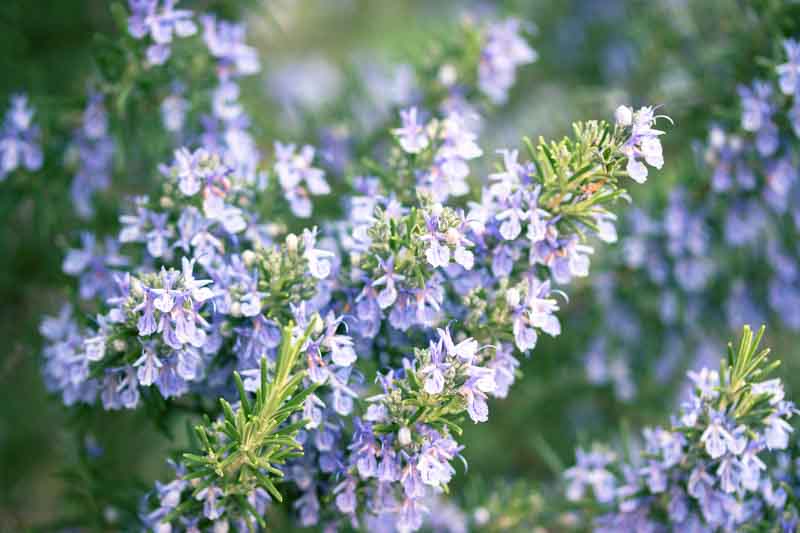Rosemary is more than just a culinary herb. Its aromatic, evergreen leaves bring flavor to countless dishes, from roasted meats to herbal teas. Beyond the kitchen, rosemary adds elegance and fragrance to gardens and patios. Its small, blue-purple flowers attract pollinators, enhancing biodiversity. Growing rosemary successfully requires understanding its unique needs, including plenty of sunlight, well-draining soil, and careful watering. With the right care, this versatile plant can thrive in both pots and garden beds, offering year-round beauty and aroma.
Cultivating rosemary also provides practical benefits. Its strong scent can deter pests naturally, while its resilience makes it ideal for home gardeners of all skill levels. Whether you aim to create a flavorful herb garden or a decorative landscape feature, rosemary combines utility and charm effortlessly. Learning how to grow it properly ensures maximum flavor, healthy growth, and a fragrant, vibrant garden space for years to come.
Understanding Rosemary: Aromatic Herb with Many Benefits

Rosemary is a versatile and aromatic herb widely appreciated for both culinary and ornamental purposes. Its fragrant, needle-like leaves add distinctive flavor to meats, soups, and teas. Beyond its use in the kitchen, rosemary brings aesthetic value to gardens, patios, and window boxes. Small blue or purple flowers bloom seasonally, attracting bees and butterflies, which support garden biodiversity. Understanding rosemary’s natural preferences is essential to growing it successfully.
This herb originates from the Mediterranean region, where warm temperatures and well-draining soils are common. Rosemary thrives in sunny locations with at least six hours of direct sunlight each day. Overwatering or poor drainage can cause root rot, while insufficient light reduces leaf aroma and slows growth. A moderate fertilization routine enhances vitality without overpowering the plant. Recognizing these basic requirements ensures healthy, flavorful rosemary whether grown in pots or garden beds.
Beyond flavor, rosemary provides practical benefits in home landscapes. Its strong scent naturally deters some pests, and its evergreen foliage offers year-round greenery. It adapts well to containers, making it suitable for small spaces or urban gardens. Regular pruning encourages dense growth, while seasonal flowering enhances visual appeal. Mastering these care principles allows gardeners to enjoy maximum flavor, aromatic leaves, and a resilient, thriving plant that enriches both meals and garden scenery.
Choosing the Right Variety of Rosemary
Selecting the proper rosemary variety is essential for achieving maximum flavor and healthy growth. Rosemary comes in several types, each suited to different climates, garden sizes, and culinary purposes. Some varieties grow tall and woody, ideal for hedges or large pots, while others remain compact, perfect for container gardening or limited spaces. Gardeners should also consider leaf color, aroma intensity, and seasonal growth habits. Understanding these characteristics helps match the plant to the environment and intended use.
One popular variety is ‘Arp’ rosemary, known for its cold hardiness and resilience in temperate regions. It produces fragrant, needle-like leaves with a strong flavor, making it ideal for culinary use. ‘Tuscan Blue’ grows upright and offers large, flavorful leaves, frequently favored by chefs for its rich aroma. Dwarf varieties such as ‘Blue Boy’ or ‘Golden Rain’ remain manageable in containers, ensuring consistent harvests throughout the year. Some varieties, like creeping types, can trail along garden beds or walls, providing both greenery and decorative appeal. Choosing a variety that fits climate, space, and culinary goals improves growth and usability.
In addition to size and flavor, gardeners should consider flowering and growth habits. Upright varieties can serve as ornamental centerpieces, while trailing types work well for hanging baskets or cascading over garden edges. Flowering patterns vary, with some producing more blooms that attract pollinators, enhancing ecological value. Leaf texture and color may also influence visual appeal in landscape design. Selecting the right rosemary variety tailored to space, sunlight, and intended use ensures that plants thrive, offering maximum flavor, aromatic leaves, and aesthetic beauty for years in both gardens and pots.
Preparing the Soil and Potting Rosemary
Rosemary thrives in well-draining soil, making proper preparation essential for healthy growth. Whether planting in the garden or in containers, choosing a light, sandy, or loamy soil prevents waterlogging, which can cause root rot. Mixing in organic matter, such as compost, improves soil structure and provides essential nutrients. A slightly alkaline soil with a pH between 6.5 and 7.5 promotes robust growth. Testing and amending soil before planting ensures the rosemary will establish quickly and develop strong roots.
For container planting, selecting the right pot is equally important. Containers must have drainage holes to allow excess water to escape. Using a high-quality potting mix designed for Mediterranean herbs helps retain moisture without becoming soggy. Adding small gravel or sand at the bottom improves drainage further. The pot size should accommodate the plant’s growth, typically at least 12 inches in diameter for mature rosemary. Repotting every two to three years prevents root crowding and keeps the plant vigorous.
Proper soil and potting setup also influence flavor and aroma. Rosemary grown in well-draining, nutrient-balanced soil produces more aromatic leaves and vibrant growth. Overly rich or poorly drained soil may result in weak stems and bland flavor. Gardeners should monitor soil moisture, allowing the top inch to dry between waterings. This careful balance of soil preparation, drainage, and container choice ensures that rosemary thrives, whether in a sunny garden bed or a sunny windowsill, producing maximum flavor and healthy, long-lasting plants.
Planting Rosemary Outdoors and Indoors
Planting Rosemary Outdoors
Planting rosemary outdoors requires selecting a sunny location with at least six hours of direct sunlight daily. The soil should be well-draining, preferably sandy or loamy, to prevent waterlogging. Space plants 2 to 3 feet apart to allow proper air circulation and growth. Planting too close increases the risk of fungal diseases and weak stems. Amending the soil with compost or aged manure improves fertility and encourages deep root development.
After planting, water rosemary moderately, allowing the top inch of soil to dry between waterings. Mulching around the base helps retain soil moisture, suppress weeds, and maintain a stable temperature for roots. Regular pruning of young plants encourages bushy growth and strengthens the stems. In colder climates, protect outdoor rosemary during winter by applying frost cloths or adding extra mulch around the root zone. Proper outdoor care ensures aromatic leaves, vibrant flowers, and resilient plants that enhance both garden aesthetics and culinary uses.
Planting Rosemary Indoors
Indoor rosemary thrives in a bright, sunny window or under supplemental grow lights for at least six hours per day. Use a well-draining potting mix formulated for Mediterranean herbs, and ensure the container has drainage holes to prevent root rot. Smaller pots are suitable for young plants, but mature rosemary requires larger containers to support root expansion and maintain healthy growth.
Water indoor rosemary carefully, letting the soil dry slightly between waterings to avoid overwatering, which can cause yellowing leaves or fungal problems. Rotate the pot regularly to ensure even sunlight exposure and balanced growth. Prune branches occasionally to encourage dense foliage and prevent legginess. Indoor rosemary also benefits from occasional fertilization with diluted organic liquid fertilizer during the growing season. Proper planting and care provide fresh, aromatic leaves year-round, while adding greenery and natural fragrance to living spaces.
Watering and Fertilizing Rosemary
Watering Rosemary
Proper watering is essential for rosemary’s growth and flavor. This Mediterranean herb prefers moderately dry conditions and well-draining soil. Overwatering can lead to root rot, while underwatering may cause leaves to dry out and lose aroma. Outdoor rosemary should be watered deeply but infrequently, allowing the top inch of soil to dry between waterings. During hot summer months, more frequent watering may be necessary, but always ensure excess water drains away. Mulching around the base helps retain moisture without creating a soggy environment and protects roots from extreme temperatures.
Indoor rosemary requires careful attention to watering routines. Use pots with drainage holes to prevent water accumulation at the bottom. Water thoroughly until excess escapes, then allow the soil to dry slightly before the next watering. Misting the leaves occasionally increases humidity, especially in dry indoor environments. Avoid keeping foliage constantly wet, which can promote fungal growth. Monitoring soil moisture and adjusting watering frequency according to season ensures strong, healthy, and aromatic plants that thrive indoors and outdoors.
Fertilizing Rosemary
Fertilizing rosemary supports vibrant foliage and enhances flavor. For garden plants, a balanced, slow-release fertilizer applied in spring and summer provides essential nutrients. Over-fertilizing can result in excessive leafy growth with reduced aroma. Organic compost or well-rotted manure incorporated into the soil is also effective, supplying nutrients gradually and improving soil structure. Maintaining moderate fertilization encourages strong stems, rich fragrance, and abundant growth.
Container-grown rosemary benefits from diluted organic liquid fertilizer every 4 to 6 weeks during the growing season. Apply the fertilizer carefully to avoid over-concentration, which may damage roots. Fertilization combined with proper watering ensures leaves remain flavorful and stems sturdy. Regularly feeding the plant supports seasonal flowering and enhances the overall health of rosemary, whether cultivated indoors on a sunny windowsill or outdoors in a garden bed.
Pruning and Harvesting Rosemary
Pruning Rosemary
Pruning rosemary is essential for maintaining its shape, encouraging bushy growth, and preventing woody stems. Regular trimming promotes airflow, reduces disease risk, and improves overall plant health. Start pruning young plants lightly to encourage lateral branches. Focus on removing dead, damaged, or weak stems while keeping the overall shape balanced. For established plants, a more thorough pruning in early spring helps stimulate vigorous growth. Avoid cutting into old, woody stems, as they may not regrow.
Using clean, sharp scissors or pruning shears is important to prevent infection. Prune after flowering to remove spent blooms and maintain a neat appearance. Light maintenance pruning throughout the growing season also encourages fresh growth and increases leaf production. Proper pruning ensures rosemary remains attractive, productive, and flavorful, whether grown in pots or garden beds. It also prepares the plant for seasonal challenges, including extreme heat or cold, ensuring long-term health and aesthetic appeal.
Harvesting Rosemary
Harvesting rosemary at the right time maximizes flavor and aroma. The best time to harvest is in the morning, after the dew has dried, when oils in the leaves are most concentrated. Focus on cutting healthy stems, leaving at least two-thirds of the plant intact to allow continued growth. Frequent harvesting encourages new growth, while over-harvesting can stress the plant and reduce vitality.
To harvest, use clean scissors to snip stems at the base, avoiding woody, old branches. Fresh rosemary can be used immediately or dried for long-term storage. Drying should be done in a well-ventilated, shaded area to preserve aroma. Proper harvesting ensures a continuous supply of flavorful leaves for cooking, teas, or decorative uses, while maintaining the plant’s health and vigor throughout the growing season.
Pests and Diseases Affecting Rosemary
Common Pests
Rosemary is relatively pest-resistant, but certain insects can occasionally cause problems. Aphids, spider mites, and whiteflies are the most common pests. Aphids cluster on new growth, sucking sap and causing leaves to curl or yellow. Spider mites thrive in hot, dry conditions, leaving fine webbing and speckled foliage. Whiteflies feed on the undersides of leaves, weakening plants over time. Early detection is key to preventing infestations from spreading.
Natural control methods are effective for rosemary. Spraying plants with a strong water stream can dislodge aphids and mites. Insecticidal soap or neem oil works well for larger infestations without harming beneficial insects. Encouraging natural predators, like ladybugs and lacewings, also helps maintain a healthy garden ecosystem. Regularly inspecting leaves, especially new growth, ensures prompt action and protects rosemary from significant damage, keeping plants vigorous and aromatic.
Common Diseases
Rosemary is generally hardy but can be affected by fungal and bacterial diseases if conditions are unfavorable. Root rot occurs in poorly drained soil and causes leaves to yellow and stems to wilt. Powdery mildew appears as a white powder on leaves, often in humid environments. Botrytis blight can affect flowers and young stems, leading to gray mold and decay. Proper cultural practices minimize disease risks.
To prevent diseases, plant rosemary in well-draining soil with adequate airflow. Avoid overhead watering, which promotes fungal growth, and prune dense areas to improve ventilation. Remove affected leaves promptly and sanitize tools to prevent spread. Using disease-resistant varieties, monitoring soil moisture, and maintaining proper spacing ensures rosemary remains healthy, flavorful, and visually appealing throughout the growing season.
Using Rosemary in Cooking and Decoration
Rosemary is a highly versatile herb that enhances both culinary creations and decorative arrangements. Its fragrant, needle-like leaves add depth to roasted meats, vegetables, and soups, providing a distinctive, aromatic flavor. Fresh rosemary sprigs can be used to infuse oils, vinegars, and teas, offering a natural, herbal touch. The strong aroma and flavor make it a staple in Mediterranean cuisine and an essential ingredient for many home cooks seeking vibrant, natural seasoning. Additionally, rosemary pairs well with garlic, lemon, and olive oil, creating simple yet flavorful combinations for marinades and dressings.
Beyond the kitchen, rosemary serves as a decorative element in gardens, containers, and indoor arrangements. Its evergreen foliage and small blue or purple flowers create visual interest throughout the year. Rosemary can be shaped into topiaries, wreaths, or garlands, making it a popular choice for festive and ornamental displays. Hanging dried sprigs or incorporating them into table centerpieces adds fragrance and charm, bridging culinary and aesthetic uses seamlessly. It also complements other herbs in mixed herb gardens, enhancing both aroma and visual appeal.
Properly grown rosemary maximizes flavor and appearance. Regular pruning encourages dense foliage, while correct watering and fertilization ensure healthy leaves for both cooking and decoration. Harvesting at the right time, preferably in the morning when essential oils are concentrated, enhances aroma and taste. By integrating rosemary thoughtfully into meals and home décor, gardeners and cooks alike can enjoy a fragrant, flavorful, and visually appealing herb that enriches culinary creations, indoor and outdoor spaces, and overall garden beauty year-round.
Propagating Rosemary for Continuous Supply
Propagating rosemary ensures a continuous supply of healthy, flavorful plants for both culinary and decorative uses. One of the most effective methods is stem cuttings. Select young, non-woody stems about 4 to 6 inches long, and remove the lower leaves to expose the nodes. Dip the cut end in rooting hormone to encourage faster root development. Plant the cuttings in well-draining potting mix and keep them in a bright location, avoiding direct sunlight until roots establish. Regular misting helps maintain humidity and supports healthy growth.
Another propagation method is layering, which works well for mature outdoor rosemary. Gently bend a low-growing branch to the soil surface and cover a section with soil, leaving the tip exposed. Over time, roots will form at the buried nodes, and the new plant can be separated from the parent once well-established. This technique allows gardeners to expand their rosemary collection without purchasing additional plants.
Seeds can also be used, but germination is slower and less reliable compared to cuttings or layering. Regardless of the method, consistent care, including proper watering, light, and occasional fertilization, ensures strong, aromatic plants. By mastering propagation techniques, gardeners can maintain a steady supply of rosemary year-round, reducing costs and ensuring plants are readily available for cooking, decoration, or gifting. Propagating rosemary not only enhances garden sustainability but also allows gardeners to preserve preferred varieties and enjoy continuous harvests for years to come.
Storing and Preserving Rosemary
Storing Fresh and Frozen Rosemary
Proper storage preserves rosemary’s flavor, aroma, and longevity. Fresh rosemary can be stored in the refrigerator for up to two weeks. Wrap the sprigs loosely in a damp paper towel and place them inside a resealable plastic bag. This method keeps the leaves hydrated while preventing moisture buildup that could cause mold. Frozen rosemary is another convenient option for long-term use. Lay sprigs flat on a baking sheet to freeze individually, then transfer them to airtight containers or freezer bags.
Freezing rosemary maintains its aroma and flavor for several months, making it readily available for cooking year-round. Frozen sprigs can be chopped directly into dishes or left whole for slow infusion in soups, stews, and sauces. Gardeners who harvest large quantities benefit most from this method, as it reduces waste and ensures a continuous supply. Using proper moisture control, airtight containers, and labeling frozen batches enhances usability and helps preserve essential oils, aroma, and flavor for extended periods.
Drying and Preserving in Oil or Vinegar
Drying rosemary is an effective preservation method for long-term use. Hang small bundles upside down in a cool, dark, and well-ventilated area until leaves are brittle. Avoid direct sunlight, which can fade color and reduce essential oils. Once fully dried, strip the leaves from the stems and store them in airtight containers away from heat and light. Dried rosemary maintains flavor for several months and can be used in cooking, teas, or as decorative elements in wreaths and arrangements.
Rosemary can also be preserved in oil or vinegar to create flavorful infusions. Place fresh sprigs in sterilized jars and cover with olive oil or vinegar. Refrigerate and use within a few weeks to maintain optimal taste. This method is especially useful for adding aroma to salads, dressings, and sauces. By combining proper drying and infusion techniques, gardeners ensure rosemary is available year-round for culinary, decorative, and aromatic purposes, maximizing both its usability and longevity.
Troubleshooting Common Rosemary Problems
Identifying and Treating Pest Issues
Rosemary is generally hardy, but pests can occasionally cause problems. Aphids, spider mites, and whiteflies are the most common offenders. Aphids cluster on new growth, sucking sap and causing leaves to curl or yellow. Spider mites thrive in hot, dry conditions, leaving fine webbing and speckled foliage. Whiteflies feed on the undersides of leaves, weakening the plant over time. Early identification is crucial to prevent infestations from spreading and causing serious damage.
Treatment options include natural remedies like spraying with a strong stream of water to dislodge pests or using insecticidal soap or neem oil for more persistent infestations. Encouraging beneficial insects, such as ladybugs and lacewings, also helps control pest populations naturally. Regular inspection of leaves and stems, especially new growth, ensures timely intervention. Maintaining plant health through proper watering, pruning, and spacing reduces susceptibility to infestations, allowing rosemary to remain vigorous and aromatic.
Managing Disease and Environmental Stress
Rosemary can suffer from fungal and bacterial diseases if conditions are unfavorable. Root rot develops in poorly drained soil, causing leaves to yellow and stems to wilt. Powdery mildew appears as white powder on leaves, often in humid environments. Botrytis blight affects flowers and young stems, leading to gray mold and decay. Environmental stress such as overwatering, drought, or frost can also weaken the plant and reduce growth.
Preventive measures include planting rosemary in well-draining soil with adequate sunlight and airflow. Avoid overhead watering and prune dense growth to improve ventilation. Remove diseased leaves promptly and sanitize tools to prevent disease spread. Using disease-resistant varieties and monitoring environmental conditions ensures rosemary remains healthy. Proper care, timely treatment, and attention to environmental stress help maintain strong, flavorful, and visually appealing rosemary throughout the growing season.
Tips for Year-Round Rosemary Growth
Ensuring Adequate Sunlight and Temperature
Rosemary thrives when provided with sufficient sunlight and a stable temperature. Ideally, the plant requires at least six hours of direct sunlight daily. Outdoor rosemary should be positioned in a sunny spot, preferably facing south, to maximize light exposure. For indoor cultivation, place rosemary near a bright window or use supplemental grow lights. Consistent sunlight promotes dense foliage, vibrant color, and strong aroma.
Temperature management is equally important for year-round growth. Rosemary prefers warm conditions but can tolerate light frost if properly protected. In colder climates, consider bringing potted plants indoors during winter or using frost cloths to shield outdoor plants. Maintaining a stable temperature reduces stress, prevents leaf drop, and supports continuous growth. By monitoring sunlight and temperature carefully, gardeners can enjoy lush, aromatic rosemary throughout all seasons, both indoors and outdoors.
Proper Watering and Maintenance
Consistent care is essential for maintaining rosemary’s health year-round. Water the plant moderately, allowing the top inch of soil to dry between waterings. Overwatering can lead to root rot, while underwatering reduces leaf aroma and slows growth. Mulching helps retain soil moisture and protects roots from temperature fluctuations.
Regular pruning encourages bushy growth, prevents woody stems, and stimulates new shoots. Remove dead or damaged branches promptly to maintain plant vigor. Fertilize lightly during the growing season with organic or slow-release fertilizer to support healthy foliage. These combined practices—adequate watering, pruning, and fertilization—ensure that rosemary remains aromatic, visually appealing, and productive throughout the year. Proper year-round care maximizes both culinary and decorative benefits of this versatile herb.
Companion Plants and Garden Placement
Choosing the right companion plants enhances rosemary’s growth and overall garden health. Rosemary thrives alongside plants that prefer similar growing conditions, including well-draining soil, full sun, and moderate watering. Herbs such as thyme, sage, and oregano are ideal companions, as they share similar Mediterranean origins and care requirements. Planting complementary herbs together maximizes space efficiency and creates a visually appealing herb garden. Additionally, companion plants can help deter pests naturally, reducing the need for chemical interventions.
Flowers like lavender, marigolds, and yarrow also pair well with rosemary, providing both aesthetic and functional benefits. Lavender shares rosemary’s sun and soil preferences, while marigolds can repel common garden pests. Yarrow attracts beneficial insects, including pollinators, which support both rosemary and surrounding plants. Proper placement ensures adequate airflow, minimizing fungal and bacterial disease risks. Grouping plants with similar needs simplifies watering and maintenance, while enhancing the visual appeal of garden beds, borders, and container arrangements.
Strategic garden placement is crucial for rosemary’s long-term success. Position taller plants to avoid shading rosemary and provide sufficient space between plants for air circulation. Container-grown rosemary should be placed in sunny, well-ventilated areas to promote healthy growth. Avoid overly damp or shaded spots, which can lead to weak stems, yellowing leaves, or disease. By thoughtfully selecting companion plants and considering garden placement, gardeners can cultivate a thriving, aromatic, and visually attractive rosemary garden that benefits both culinary and ornamental purposes throughout the year.
FAQ About Growing Rosemary in Pots and Gardens
What is the best soil for growing rosemary?
Rosemary thrives in well-draining soil with a sandy or loamy texture. Mixing in compost or aged manure improves fertility and supports root growth. Avoid heavy clay or waterlogged soil, which can cause root rot. Proper soil ensures healthy, aromatic plants with strong stems and vibrant foliage.
How often should I water rosemary?
Rosemary prefers moderately dry conditions. Water deeply but allow the top inch of soil to dry between waterings. Overwatering leads to root rot, while underwatering reduces leaf aroma. Indoor plants require less frequent watering than outdoor ones, but always monitor soil moisture and adjust according to season and temperature.
Can rosemary be grown indoors year-round?
Yes, rosemary can thrive indoors if it receives at least six hours of bright sunlight or supplemental grow lights daily. Use well-draining pots with drainage holes, and maintain moderate watering. Rotate plants regularly to ensure even growth, and prune occasionally to maintain bushiness and maximize aroma and foliage production.
How do I propagate rosemary effectively?
The easiest methods are stem cuttings and layering. Take 4–6 inch young stems, remove lower leaves, and root them in well-draining soil. Layering involves burying a flexible branch’s section while keeping the tip exposed. Seeds are slower to germinate and less reliable. Proper propagation ensures continuous supply of aromatic plants.
What are common pests and diseases of rosemary?
Rosemary can be affected by aphids, spider mites, whiteflies, root rot, powdery mildew, and botrytis blight. Maintain well-draining soil, prune dense growth, avoid overhead watering, and inspect plants regularly. Natural predators, insecticidal soap, and neem oil help manage pests, while sanitation and disease-resistant varieties prevent fungal or bacterial problems.
Conclusion
Growing rosemary successfully requires attention to sunlight, soil, watering, and proper care. Choosing the right variety, planting in well-draining soil, and providing adequate sunlight ensures strong, flavorful plants. Regular pruning, fertilizing, and pest management maintain health and maximize aroma. Indoor and outdoor cultivation, combined with proper storage and preservation, allows year-round enjoyment of this versatile herb. Propagation techniques ensure a continuous supply for culinary, decorative, and aromatic uses. By following these expert tips, gardeners can cultivate thriving rosemary plants that enhance meals, beautify gardens, and provide fragrance and flavor throughout every season.






